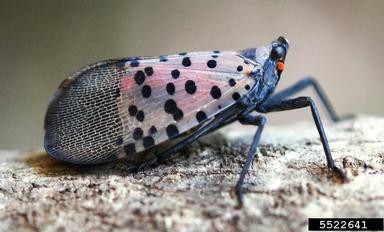Spotted Lanternfly
Emerging Threat Note: This insect has been detected in Tennessee but is not widely established. We actively monitor for this pest and encourage residents to report potential sightings.
Introduction
The spotted lanternfly (SLF; Lycorma delicatula) is an invasive plant hopper, that was first detected in the United States in 2014; in Tennessee, SLF has been detected only in Davidson and Wilson Counties. This pest is primarily known to attack its preferred host, tree of heaven (Ailanthus altissima) although well over 70 species of plants can be impacted. Some of these other host plants include apples, grape, and hops, and a variety of other fruit and ornamental trees, shrubs, and vines. This insect also feeds on maple, walnut, and poplar.
SLF is a sapsucking insect, feeding on the water and nutrients in plants and producing a byproduct called honeydew as it feeds. While this type of feeding does not directly cause a tree to decline, it can act as a plant stressor which can make the plant more susceptible to other insects and diseases or to abiotic damage. The byproduct honeydew can also coat areas underneath infested plants with a sticky substrate, and frequently also allows the growth of sooty mold, which can be an additional nuisance in residential areas.
This insect is a pest in orchards and other fruit and ornamental businesses, and has also proved to be a pest in residential areas. Management of SLF may help lessen the impact it has on commodities and reduce its nuisance in residential and urban areas. In Tennessee, we monitor for SLF to respond quickly to detections.
Identification
The spotted lanternfly undergoes several life stages which can be identified at different times of the year. From late fall through winter, egg masses may be present; these masses are often tan-colored and look like spattered mud and may be laid on tree trunks, branches, other plants, or even other outdoor surfaces like walls, patio furniture, recreational vehicles, trailers, and even on smaller vehicles.
During the spring, nymphs emerge from egg masses. Early nymphs are black with small white dots and often walk with the front of their bodies elevated. Later nymphs, which may molt in June or July, develop bright red colors with some black stripes and white dots.
In late summer and early fall, the adults emerge. Adults have forewings which are tan with black spots at the front transitioning to a speckled band near the rear. Typically adults will hold their wings tent-like over their bodies, so that only the forewing may be visible. Hindwings have distinct bright red patches with black spots when visible These insects frequently aggregate, making them easier to spot in large numbers when they gather.
Symptoms of SLF damage include production of honeydew (the byproduct of their feeding) and buildup of sooty mold on that honeydew. While SLF may not directly kill trees, it can stress a tree and make it more susceptible to other issues; a declining tree may not be indicative of SLF by itself but could be a result of SLF and other factors.
If you spot spotted lanternfly in Tennessee, please report the pest.
Current Situation
In Tennessee, we have only detected spotted lanternfly in two counties in middle Tennessee, so we continue to focus efforts on monitoring and surveying for SLF so that we can respond to any new SLF detections in our state.
SLF is native to China, India, Japan, South Korea, and Vietnam and was first detected in the United States in Pennsylvania in September 2014. T Since the initial detection, this pest has spread to 14 states, with recent detections in southwest Virginia and western North Carolina, and now in Davidson and Wilson Counties in Tennessee. An updated national distribution map can be found at the link in the Resources section below.
Spotted lanternflies are invasive and can spread rapidly when introduced to new areas. While the insect can walk, jump, or fly short distances, its long-distance spread is facilitated by people who move infested material or items containing egg masses.
Management
In Tennessee, we have only detected spotted lanternfly in one county in middle Tennessee, so we continue to focus efforts on monitoring and surveying for SLF so that we can respond to any new SLF detections in our state.
In areas where new populations of SLF are detected, some management strategies can be utilized to attempt to eradicate the pest before it becomes well-established. These methods include extensive surveying to determine the area of infestation, and then various management tools depending on the situation. These tools include tree banding, insecticides, egg mass survey and removal of egg masses, herbicide control of tree-of-heaven, and combinations of these strategies.
Because SLF is a pest of many fruit species, vineyards, orchards and other agriculture and crop-tree businesses may manage SLF more proactively based on Economic Thresholds for their particular crop.
In areas where SLF has established in other states, some landowners or land managers have elected to manage SLF as needed in key areas or to reduce high populations where SLF numbers are causing a nuisance.
What Can You Do?
To prevent the spread of spotted lanternfly, an easy step to take is to inspect outdoor furniture, recreational vehicles, boats, etc. for egg masses before moving those items from infested areas. Reducing the potential movement of egg masses can help prevent long distance movement of this pest.
Report any suspected spotted lanternflies in Tennessee to the TN Department of Agriculture through either the Report a Pest form (link below) or by emailing information to Spotted.Lanternfly@tn.gov. If possible, attempt to collect the insect or take photos that can be used in proper identification.

